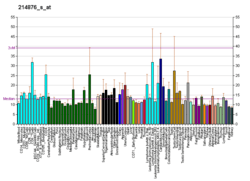TUBGCP5
Gamma-tubulin complex component 5 is a protein that in humans is encoded by the TUBGCP5 gene.[5][6] It is part of the gamma tubulin complex, which required for microtubule nucleation at the centrosome.
See also
References
- 1 2 3 ENSG00000275835, ENSG00000280807 GRCh38: Ensembl release 89: ENSG00000276856, ENSG00000275835, ENSG00000280807 - Ensembl, May 2017
- 1 2 3 GRCm38: Ensembl release 89: ENSMUSG00000033790 - Ensembl, May 2017
- ↑ "Human PubMed Reference:".
- ↑ "Mouse PubMed Reference:".
- ↑ Murphy SM, Preble AM, Patel UK, O'Connell KL, Dias DP, Moritz M, Agard D, Stults JT, Stearns T (Nov 2001). "GCP5 and GCP6: two new members of the human gamma-tubulin complex". Mol Biol Cell. 12 (11): 3340–52. PMC 60259
 . PMID 11694571. doi:10.1091/mbc.12.11.3340.
. PMID 11694571. doi:10.1091/mbc.12.11.3340. - ↑ "Entrez Gene: TUBGCP5 tubulin, gamma complex associated protein 5".
Further reading
- Bittel DC, Kibiryeva N, Butler MG (2006). "Expression of 4 genes between chromosome 15 breakpoints 1 and 2 and behavioral outcomes in Prader–Willi syndrome.". Pediatrics. 118 (4): e1276–83. PMID 16982806. doi:10.1542/peds.2006-0424.
- Gerhard DS, Wagner L, Feingold EA, et al. (2004). "The status, quality, and expansion of the NIH full-length cDNA project: the Mammalian Gene Collection (MGC).". Genome Res. 14 (10B): 2121–7. PMC 528928
 . PMID 15489334. doi:10.1101/gr.2596504.
. PMID 15489334. doi:10.1101/gr.2596504. - Suzuki Y, Yamashita R, Shirota M, et al. (2004). "Sequence comparison of human and mouse genes reveals a homologous block structure in the promoter regions.". Genome Res. 14 (9): 1711–8. PMC 515316
 . PMID 15342556. doi:10.1101/gr.2435604.
. PMID 15342556. doi:10.1101/gr.2435604. - Ota T, Suzuki Y, Nishikawa T, et al. (2004). "Complete sequencing and characterization of 21,243 full-length human cDNAs.". Nat. Genet. 36 (1): 40–5. PMID 14702039. doi:10.1038/ng1285.
- Chai JH, Locke DP, Greally JM, et al. (2003). "Identification of four highly conserved genes between breakpoint hotspots BP1 and BP2 of the Prader-Willi/Angelman syndromes deletion region that have undergone evolutionary transposition mediated by flanking duplicons.". Am. J. Hum. Genet. 73 (4): 898–925. PMC 1180611
 . PMID 14508708. doi:10.1086/378816.
. PMID 14508708. doi:10.1086/378816. - Strausberg RL, Feingold EA, Grouse LH, et al. (2003). "Generation and initial analysis of more than 15,000 full-length human and mouse cDNA sequences.". Proc. Natl. Acad. Sci. U.S.A. 99 (26): 16899–903. PMC 139241
 . PMID 12477932. doi:10.1073/pnas.242603899.
. PMID 12477932. doi:10.1073/pnas.242603899. - Nagase T, Kikuno R, Ohara O (2002). "Prediction of the coding sequences of unidentified human genes. XXI. The complete sequences of 60 new cDNA clones from brain which code for large proteins.". DNA Res. 8 (4): 179–87. PMID 11572484. doi:10.1093/dnares/8.4.179.
This article is issued from
Wikipedia.
The text is licensed under Creative Commons - Attribution - Sharealike.
Additional terms may apply for the media files.




